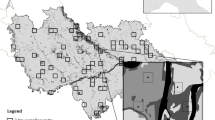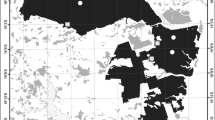Abstract
Environmental conditions developing at the boundary of windfall- and fire-damaged forest biocenoses at different stages of progressive succession have a positive effect on the total abundance of rodents, but the role of ecotone in forming the structure of their microhabitats is ambiguous. The complex of biotic and abiotic conditions in the ecotone has a positive influence on the size of shrub coverage area and the abundance of saplings, whereas the influence of the edge effect on other microhabitat parameters (namely, herbaceous and moss coverage) is negative or neutral.
Similar content being viewed by others
References
Odum, E., Basic Ecology, Philadelphia: Saunders, 1983. Translated under the title Ekologiya, Moscow: Mir, 1986, vol.2.
Lidicker, W.Z., Jr., Responses of mammals to habitat edges: An overview, Landsc. Ecol., 1999, vol. 14, pp. 333–343.
Ries, L., Fletcher, R.J., Battin, J., and Sisk, T.D., Ecological responses to habitat edges: Mechanisms, models, and variability explained, Annu. Rev. Ecol. Evol. Syst., 2004, vol. 35, pp. 491–522.
Hansson, L., Landscape ecology and stability of population, Landsc. Plan., 1977, no. 4, pp. 85–93.
Stenseth, N.C., Spatial heterogeneity and population stability: Some evolutionary consequences, Oikos, 1980, vol. 35, pp. 165–184.
Manson, R.H., Ostfeld, R.S., and Canham, C.D., Responses of a small mammal community to heterogeneity along forest–old field edges, Landsc. Ecol., 1999, vol. 14, no. 4, pp. 355–367.
Pardini, R., Effects of forest fragmentation on small mammals in an Atlantic forest landscape, Biodiv. Conserv., 2004, vol. 13, pp. 2567–2586.
Starcevic, M., Mrakovcic, M., and Brigic, A., Effects of edges on small mammal communities in Dinaric beech–fir forest, Abstr. VI Eur. Congr. of Mammalogy, Paris, 2011, p.57.
Kingston, S.R. and Morris, D.W., Voles looking for an edge: Habitat selection across forest ecotones, Can. J. Zool., 2000, vol. 78, pp. 2174–2183.
Silva, M., Abundance, diversity and community structure of small mammals in forest fragments in Prince Edward Island National Park, Canada, Can. J. Zool., 2001, vol. 79, pp. 2063–2071.
Anderson, C.S., Cady, A.B., and Meikle, D.B., Effects of vegetation structure and edge habitat on the density and distribution of white-footed mice (Peromyscus leucopus) in small and large forest patches, Can. J. Zool., 2003, vol. 81, pp. 897–904.
Tallmon, D.A. and Mills, L.S., Edge effects and isolation: Red-backed voles revisited, Conserv. Biol., 2004, vol. 18, no. 6, pp. 1658–1664.
Delattre, P., Morellet, N., Codreanu, P., et al., Influence of edge effects on common vole population abundance in an agricultural landscape of eastern France, Acta Theriol., 2009, vol. 54, no. 1, pp. 51–60.
Wolf, M. and Batzli, G., Forest edge: High-or lowquality habitat for white-footed mice (Peromyscus leucopus)?, Ecology, 2004, vol. 85, no. 3, pp. 756–769.
Wilson, J.W., Stirnemann, R.L., Shaikh, Z.S., and Scantlebury, M., The response of small mammals to natural and human-altered edges associated with Afromontane forests of South Africa, For. Ecol. Manag., 2010, vol. 259, pp. 926–931.
Harris, L.D., Edge effects and conservation of biotic diversity, Conserv. Biol., 1988, vol. 2, pp. 330–332.
Sibgatullin, R.Z., The 1995 catastrophic windfall and its consequences for forests of the Visim Biosphere Reserve, Problemy zapovednogo dela: Mat-ly nauch. konf. (Problems of Nature Reserve Management: Abstr. Sci. Conf.), Yekaterinburg, 1996, pp. 99–101.
Kucheruk, V.V., Quantitative census of the main species of pest rodents and shrews, in Metody ucheta chislennosti i geograficheskogo raspredeleniya nazemnykh pozvonochnykh (Methods for Evaluating the Abundance and Geographic Distribution of Terrestrial Vertebrates), Moscow, 1952, pp. 9–45.
Bujalska, G., Lukyanov, O.A., and Mieszkowska D., Determinants of local spatial distribution of numbers of red-backed vole island population, Russ. J. Ecol., 1995, vol. 26, no. 1, pp. 35–45.
Lukyanova, L.E., Postcatastrophic successions of a rodent population, Sib. Ekol. Zh., 2015, no. 6, pp. 832–841.
Lukyanova, L.E. and Bobretsov, A.V., Local abundance distribution of sympatric forest vole species under microhabitat conditions of destabilized and stable habitats, Usp. Sovrem. Biol., 2008, vol. 128, no. 5, pp. 541–552.
Lukyanova, L.E. and Bobretsov, A.V., Microhabitat selection by the bank vole (Clethrionomys glareolus Schreber, 1780) under destabilized and stable habitat conditions, Vestn. Tomsk. Gos. Univ., Ser. Biol., 2014, no. 4 (28), pp. 88–107.
Pires, A.S., Fernandez, F.A.S., Freitas, D.D., and Feliciano, B.R., Influence of edge and fire-induced changes on spatial distribution of small mammals in Brazilian Atlantic forest fragments, Stud. Neotrop. Fauna Environ., 2005, vol. 40, no. 1, pp. 7–14.
Author information
Authors and Affiliations
Corresponding author
Additional information
Original Russian Text © L.E. Lukyanova, 2017, published in Ekologiya, 2017, No. 3, pp. 192–198.
Rights and permissions
About this article
Cite this article
Lukyanova, L.E. Effect of ecotone at the boundary of windfall- and fire-damaged forest biocenoses on the abundance of rodents and characteristics of their microhabitats. Russ J Ecol 48, 245–250 (2017). https://doi.org/10.1134/S1067413617030092
Received:
Published:
Issue Date:
DOI: https://doi.org/10.1134/S1067413617030092




